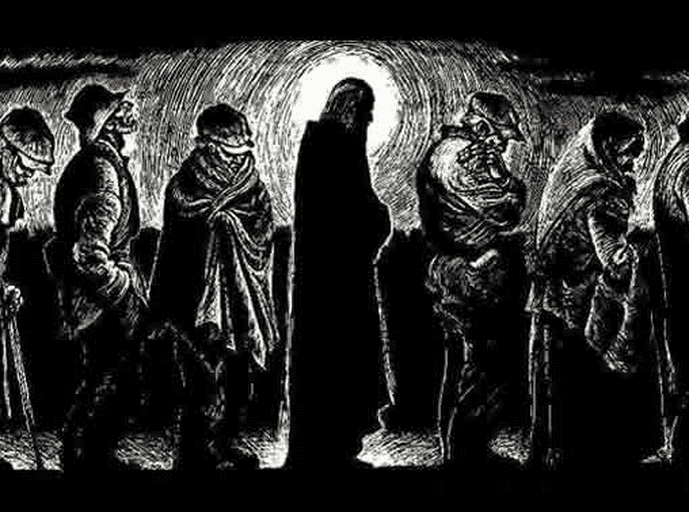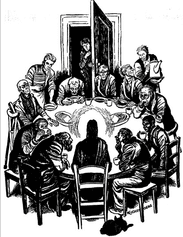The local church as the “thin place” and “the space between”: “Thin place,” a sacred place or space where unseen mysteries of the other world (i.e., “the heavenlies”) and the material places of the earth touch. A “thin place” is where one can walk in two worlds at the same time, a place of liminality—a place where the two worlds (seen and unseen) are fused or mingled together, yet where distinctions can be discerned. “A thin place” is where the boundary between heaven and earth is especially narrow, a place where a sense of the divine is more readily perceived. The church (a local church) as God’s household-temple is such a “thin place.” The “space between” is the common or transitional space where boundaries are fluid, a mix of human activity, specifically that space between the build environment. The church (a local church) is such a “space between” [from C. M. Anderson, “The Sacred “Thin” Space Between: (Eph 3:16): The Temple- Church as Revelation of God's Reconciling Mystery and Its Potential for Church Growth Outcomes” (paper)].
*This is the third instalment of quotes from my presentation on "Church (local), the poor and their neighborhood," which are focused on applying the Bible, especially in the context of "neighborhood." For all the posted "Church (local) quotes >>
0 Comments
 It is understandable that suburban, exurban, and affluent church congregations, typically, do not see the link between the gospel and the flourishing of their neighborhood. Here’s the problem: Which neighborhood? Whose neighborhood? And, O by the way, our neighborhoods by definition are flourishing. Suburban and exurban congregations tend to be a mix of like-minded, demographically related, geographically similar people who travel various distances away from their own neighborhoods to a building in an incongruent neighborhood (to most of the congregation), the place of gathered, weekly worship—the building they call “our church.” This is the habitus of Christians within suburban congregations each week. A habit that teaches, forms, and qualifies an understanding of the gospel. The neighborhood is a space we leave for church, more a concept of social structure rather than a concrete place or association; a place where my house is located, but detached from my church experience and faith. This offers a building-centered church experience that more easily relates to the command to love the Lord your God, but has no real, concrete relationship to love your neighbor(s) as yourself. In a real way, a suburban church congregation is without a neighborhood—at least without a specific one. There is no neighborhood for the church to ultimately be identified with, for the members are mostly transported from their actual neighbors and family in real neighborhoods to a one-size-fits-all neighborhood that is stuffed inside a building. Rather than a public faith that engages a neighborhood, practicing the second-which-is-like-unto-the-first-command to love one’s neighbor, more affluent and suburban/exurban congregations form a more privatized, truncated, thin faith (i.e., Christian experience) and, as a result, there is a bent toward more cognitive (knowledge-based) and behavioral outputs (i.e., activities) and outcomes. Thus, the church, the gospel, and discipleship are all aligned with a neighborhood-less social grouping, separated from the day to day realities of life in a neighborhood. Unexpectedly, the early church grew, not because they verbally witnessed, had an outreach program, or held bible studies; but, because they lived their daily lives in contrast to the world around them—their habits were different and their habits were noticed by their neighbors. And, not just in cultured, acceptable behavioral ways, but in concrete, intentional actions. Their discipleship included helping the poor, rescuing exposed (abandoned, thrown away) babies, adopting orphaned children, rescuing prostitutes (temple slavery), and meeting the needs of the widows (who were the most vulnerable and under-resourced population in the empire). This is how the body of Christ, the church, grew. The presence of Jesus was experienced in concrete intentional action through the church—practicing the presence of Christ amid neighbors. Typically for the non-urban churches, evangelism and mission is understood, not by kingdom righteousness, advocacy for injustice, and social action on behalf of a neighborhood, but by numbers of people funneled into a building for a worship service, a bible study, or special fellowship event—a head count of conversions or transfer growth. Church leadership institutes activities and behaviors to draw the unchurched out (and away) from their neighborhood (without actually going into those neighborhoods) and into the building (they call church), which is neighborhood-less (or at least in a neighborhood that is not their own). When the liminality of church life is separated from the daily life of a neighborhood, the gospel and its associated outputs (i.e., activities) and outcomes are disconnected from the life of their neighbors. When one’s own neighborhood consists of those who have had the privilege of flourishing and a church congregation is detached from a neighborhood, the Christian experience affirms a gospel unrelated to the flourishing of a neighborhood. Christian behaviors, then, are limited to relationships and social associations that affirm “traditional” cultural values (within that building) rather than including behaviors that understand the dynamic relationship between structures, systems, and people’s well-being within the context of a neighborhood. The gospel of the suburban church is a limited, one dimensional gospel. A one-dimensional gospel indicates solely a person/God dynamic relationship; whereas a multi-dimensional gospel includes the person/God dynamic and, also, creation/God, person/creation, and person/person. The habits of the suburban and exurban church makes it difficult to see the link between the gospel and the flourishing of a neighborhood.  For a more comprehensive study on the relationship between the gospel and social action, please take the time to read through my Wasted Evangelism, an exegetical commentary on Mark's Gospel. I am also working on another volume on Church Growth from an exegetical study in Ephesians, hopefully titled, Not (just) By the Numbers: Getting Beyond Building-Centered Church Growth in Search of Other Biblical Outcomes—a Thesis on Biblical Temple-Church Growth; see some posts related to these studies (evangelism and Not by the Numbers). Platform for change: Output and Outcome Church Growth TrajectoriesDespite the musings of some that the NT church (and the early Jesus movement) was a protest against an oppressive Empire, the apostolic and early church lacked the power and a public platform for social and cultural change. However, the household temple-church filled in Spirit was and is the platform for making known God’s cosmic reconciliation through which cultural and social change was and is inaugurated in the world, particularly the worlds of our neighborhoods and communities. Christians did not “take to the streets,” but made known God’s cosmic reconciliation in the midst of household temple-churches through the reoriented relationships of reciprocity. Paul was calling, in particular, Gentile Christian men (i.e., the husbands-fathers-masters) to act against their own self-interests and against the norms of the dominant culture, literally to take up arms against the Empire by adopting the reconciled, sacrificial love of Messiah Jesus, demonstrating reciprocity to wives, children, and slaves. They must now live “no longer as the Gentiles walk” (4:17). Paul does not seek to overthrow the authority structures of the culture in which the Ephesian church found itself. But what he does do is instruct those in the family of God, within the all-welcoming worshipping venue, a new way of relating to one another in Messiah. This should affect what we consider as church growth. Buildings and addressed spaces do not foster relationships and authorities in a vacuum. In fact, a building decodes the concept of “the church.” This is true of a building-centered church experience, for our “church” experience and how we read and understand the Bible exist within a complex web of social, cultural, and religious meanings, habits, and relationships that are manifested in the fabric of our sacred spaces. In other words, a building-centered church experience fosters certain types of relationships, affirms a different set of authorities, and establishes a different set of burecratic powers than does a household venue as church. Today, church buildings tend to gather together the like-minded and those politically and economically similar—causing our building-centered sacred space and religious habits to be formed separate from other lesser individuals. Additionally, within a building-centered church experience the “power” a building has over people cannot be avoided, namely “the power of management, of expertise, or pure power against pure power,” while at the same time, ironically expressing “the power-refusing cross of Christ.” Perhaps, the reading of the command to be filled (Eph 5:18c) and the reoriented household code (5:22–6:9) offered throughout this paper opens other potential reasons for Paul’s final section—directly after the table—on the church, Messiah, and the powers. One could argue the need for sacred space identity in a place, but such arguments are deeply cultural. Paul locates the identity of the church both “in the heavenly places” (Eph 1:20–23; 2:6; 3:10) with the enthroned Messiah Jesus and “on earth” locally in household temple-churches. Yet, it is within the household temple-church(es) that God calls those in power, not to force others to submit, but for themselves to obey him through submission to others in the reciprocity of human relationships. As Dudrey insightfully points out, God “calls us not to seek empowerment, but to live out our lives in the moral and spiritual equivalent of martyrdom.” More specifically, God calls those with power into this new life of “martyrdom.” Within and through the household temple-churches that were spreading throughout the Empire, what it was to be human had been “irrevocably altered.” Albeit vast numbers of people flowed into the church—and that is certainly church growth as well—yet the filling in Spirit command and the reoriented household code provoke us to imagine church growth in terms of reconciliation among people, namely to recognize the value intrinsic to others and act in ways that promote outcomes of personhood (i.e., intentional reciprocity). As Megan Shannon Defranza has so poignantly observed in her book, Sex Difference in Christian Theology: Male, Female, and Intersex in the Image of God, “Postmodern vigilance on behalf of others and the Christian command to love our neighbors as ourselves call us to more careful attention to persons as they are found in the real world rather than in the ideal world of philosophical and theological systems.” Paul’s description of the household temple-church places real people from all strata of life together as church, literally giving priority of place to lesser persons and, more strikingly, calling those in power to show reciprocity in their associations with others. Therefore, potential church growth should also include outcomes of personhood and appropriate outputs (i.e., “church” activities) that ensure such outcomes. *For those following my thoughts on "Church Growth" here is my conclusion to the paper (and hopeful chapter in a forthcoming book) as I prepare for the upcoming November 2015 annual meeting of the Evangelical Theological Society in Atlanta.
Other Not by the Numbers posts >> Intentional outputs promoting social mapping affirming mutuality and equality among persons10/31/2015 Introduction to the last section: A Temple-Church Architecture Reorienting Trajectory: Personhood OutcomesWith a contextually wider view of the Ephesians Letter, one of the outcomes of God’s cosmic reconciliation through Messiah can be seen in the transformation of the principal Roman social unit into relationships of reciprocity [see Russ Dudrey, “‘Submit Yourself to One Another’," RestQ, v 41/1]. This is even more substantial when we consider that the household code setting is framed within a temple-church venue, God’s new sacred place where believers gathered as the locally enfleshed fullness of Messiah’s body (cf. 1:22-23). Our observations of the code and its literary connection to the Spirit-filled temple-church (see Eph 2:19-22; 5:18) provoke us to reimagine potential relevant outcomes for the significance of how Paul works the household code text (5:22-6:9). The priority of the “lesser” household member (i.e., wives, children, slaves) in each pairing and the leveling of the male head of household through the expected reciprocity to the “lesser” members suggest that personhood (or the recognition of personhood) is an appropriate contextual outcome for the command to be filled in Spirit (5:18c). God’s new humanity (2:15c) is a result (an outcome) of his cosmic reconciliation (his output). Thus, the growing household temple-church in Spirit (2:19-22; 5:18-6:9) is God’s recreated sacred space where (a local) church growth is measured by local “church” habits and intentional outputs that promote a socially constructed reality wherein social mapping affirms mutuality and equality among persons (outcomes). *For those following my thoughts on "Church Growth" here are some concluding thoughts as I prepare for the upcoming November 2015 annual meeting of the Evangelical Theological Society in Atlanta.
Other Not by the Numbers posts >> Heading into my last section of my ETS paper on Ephesians 5:18 and the following household code. The focus of the paper is to build an exegetical foundation for church growth (the definition, outputs, and outcomes). For those interested and keeping up on my study, here is the introduction to the last section (or at what appears as the last section for now.Reorienting Trajectories of Temple-Church Architecture: Personhood Outcomes The Ephesians 5 household code passage is perhaps one of the more contentious texts concerning Christian approaches to marriage and, generally, for the inferences made from it regarding the “biblical” role of women in the church and in society. There are three general categories for how the Ephesians wives-husband passage (5:22-33 and other NT women/wives related texts) is classified in regards to Christian-related concepts of the “role of women.” There is the patriarchy view that leaves the man as the sole authority within the family and central to all social ordering in and outside the church. In regards to marriage, women exist to be wives for the purpose of serving the male. The complementarian view, on the other hand, understands that men and women are equals as image bearers of God and both, as Christians, are equal with respect to salvation and their position before God, equally valued in the sight of God. However, their roles and responsibilities within the church are not equal; women ought not to serve in positions of church lay-leadership (i.e., elders, under-shepherds, etc.) or in ordination as pastors. In marriage and within the household, women are to submit to their husband’s spiritual and decision-making leadership. Finally, the egalitarian (or mutuality) view promotes gender equality, viewing home-life as co-partners sharing equally in all aspects of married life and advocates for the inclusion of women in all leadership roles and offices within the Christian community and in the church. In light of our contextual observations in the last section, however, we should consider another paradigm to determine Paul’s intentions for his use of the household code (5:22-6:9) following his command to be filled in Spirit (5:18). There is a strong and dynamic intra-textual relationship between the Ephesians 5 filling command, the following household code, and the church as temple (Eph 2:19-22; 5:18-6:9). This suggests that the relationship-trio (5:22-6:9) functions as the architecture of the temple-church, that is, at least in part, a manner in which the whole building, being fitted together, is growing into a holy temple in the Lord, in whom you also are being built together into a dwelling of God in Spirit (Eph 2:21-22). In other words, Paul harnesses the concept of the well-established Roman household code or table for at least one answer to the questions How does the temple-church grow? and, in light of the command to be filled in Spirit, How is the temple-church being built together into a dwelling of God in Spirit? The Eph 5:15-6:9 pericope, then, should be considered a potential church growth text that presents potential trajectories that promote growth outputs and outcomes beyond numbers of people. *For those following my thoughts on "Church Growth" as I prepare a paper for the upcoming November 2015 annual meeting of the Evangelical Theological Society in Atlanta. This portion comes from the paper entitled, "Domesticating Church Growth (Eph 5:18-6:9): The Spirit-Filled Temple-Church Architecture (Wives-Husbands/Children-Fathers/Slaves-Masters) and Outcomes of Personhood."
Other Not by the Numbers posts >> The ecclesiastical and liturgical changes that developed at the move from domestic-center church to building-centered church set the Christian community on social mapping trajectories that have affected, not only views on the role of women in the church, but how we also define and understand church growth outputs and outcomes. The distinct change from domestic space with more informal domestic relationship oriented habits and associations to a more formal institutionalized ecclesiastical space has, over two plus millennia, created specific social ramifications for the church and for doing church. And, as well, this has influenced what we consider acceptable church growth texts. We should not underestimate the power of a building as “a church.” As Jeanne Halgren Kilde reminds us, the “material world is far from neutral,” nor is a “church building” any less neutral [Sacred Power, Sacred Space: An Introduction to Christian Architecture and Worship, 199]. Although reflecting on earlier church history, yet still valid to our contemporary building-centered church, Kilde continues, “Christian space is dynamic space. It is powerful space” [199]. The power of sacred space, including a building designated as “a church,” changes everything. Power shifts. Sustainability becomes necessary. Maintaining approved and acceptable hierarchies become absolute. Habits associated with the use of a “sacred” building and the division it makes with everyday life orients our social mapping. A building-centered church experience is not nuetral to the church’s associations and human relationships in and outside the church community (i.e., a local church community). The use of building-centered sacred space as church is a language itself, a specific “god-talk” that that creates a separation from other non-sacred church space, reinforcing a incongruence, a cleavage between everyday life and, also, a barrier between human and human social mapping (or a redefining of social mapping). The shift to now long entrenched habits and meaning associated with building-centered, addressed sacred space made with human hands known as “a church” has provided an interpretive lens for reading the New Testament. The question is not whether we should have specific buildings as centers of “church” activities, but how such building-centered church experiences influence and mold both our interpretation of biblical texts and our understanding of church—and thus, form our parameters for church growth. Interestingly, the Ephesians household code suggests how “members” are understood as persons, and in doing so, there is potential to move beyond mere numbers of people as the only outcome for church growth. *For those following my thoughts on "Church Growth" as I prepare a paper for the upcoming November 2015 annual meeting of the Evangelical Theological Society in Atlanta. This portion comes from the paper entitled, "Domesticating Church Growth (Eph 5:18-6:9): The Spirit-Filled Temple-Church Architecture (Wives-Husbands/Children-Fathers/Slaves-Masters) and Outcomes of Personhood."
Other Not by the Numbers posts >> Just finished the long exegetical section on Ephesians 5 command to be filled in Spirit for my up-coming November Evangelical Theological Society paper . . . some editing I am sure, but drafted! Here is the summary for those interested:A contextual-exegetical exploration and summary places the Ephesians 5 filling command within the sphere of God’s new temple-church (Eph 2:19-22). The community of believers is God’s new sacred space, his multihousehold temple-church that is a dwelling place of God in Spirit, which is a reflection modeling of God’s cosmic reconciliation. Herein lays the potential importance of the following household code: the relationship-trio (wives-husbands, children-fathers, slaves-masters) must in someway indicate the architecture of the new temple, first, as the space where the cosmic reconciliation begins to expand, but also, second, in demonstrating the subversive nature of the work of God through the Messiah in reordering the basic unit of society under the new paterfamilias, the Father. The household code, then, offers trajectories of significance for church growth outputs and outcomes. The relationship-trio, somehow, pushes us to reimagine church growth beyond mere numbers of people in a “sanctuary” built with human hands; potential outcomes that require evangelistic outputs (i.e., activities) that are meant to subvert the status quo and, as a result, demonstrate a reordering reflective of God’s cosmic reconciliation. *For those following my thoughts on "Church Growth" as I prepare a paper for the upcoming November 2015 annual meeting of the Evangelical Theological Society in Atlanta. Other Not by the Numbers posts >>
The fullness/filling, the Spirit, and the Ephesians temple-church. Andreas J. Köstenberger points out that “God’s subjection of all things under one head—that is, Christ (Eph 1:10)—sets the remainder of the epistle in proper perspective.” Paul, it should be noticed, takes up considerable space in the Letter linking the concept of filling/fullness, the church, and the Spirit throughout the Ephesians text. The Ephesians 5 filling command, then, is associated with God’s summing up of all things under Messiah, which links the filling to God’s cosmic reconciliation (Eph 1:10; 1:23; 2:16; 4:4, 12, 16; 5:23, 28, 30; cf. Rom 12:4-5; 1 Cor 12; Col 1:18; 3:15). The range of Ephesian referents associated with the work of God through the Messiah (the Head) and his church (Messiah’s body) to the cosmic reconciliation of his Lordship over alienated earth and heaven suggests that the Ephesians 5 filling command is to move us to reimagine the redemptive reordering of human existence. This suggests the same for the household code that syntactically follows (5:22-6:9) the filling command (5:18). As the temple-church is a reordering of human relationships (i.e., believing Jews and Gentiles together in one household-church, Eph 2:11-22), so also the household code is a reordering of the status quo and points us toward the concept of personhood as reflected in the relationship-trio. In chapters 1-3, Paul stacks up relevant terms (Messiah, body, filling, fullness, Spirit, head, subjection) to ensure the hearer/readers a vivid imagination of the church’s relationship to God’s redemptive/reconciliation action through the Son (the Head). In Eph 5:18 the concept of filling is also linked to the Spirit, drawing our attention back to Paul’s description of the Ephesians 2 growing/expanding temple-church (vv. 19-21), which is being built together into a dwelling of God in the Spirit (v. 22). The Ephesians 5 household code (5:22-6:9) even has a conceptual link to the Ephesians 2 temple-church in Paul’s reference to the Ephesus church as God’s household (v. 19c), where God is the paterfamilias. There are sufficient antecedent lexical and conceptual marks in the Ephesians 2 growing temple-church to indicate an epistolary connection to the Ephesians 5:18 command to be filled in Spirit and the following household (5:22-6:9). The sphere of the Spirit in Ephesians ought to influence the interpretive imagination of the Ephesians 5 filling command. The believers in Ephesus are sealed in Him with the Holy Spirit of promise (Eph 1:13) and they are not to grieve the Holy Spirit by whom they were sealed for the day of redemption (4:30; cf. Isa 63:10-11), connecting the Ephesians 5 filling to the Old Testament. The Spirit is related to temple images: the community of believers of Jews and Gentiles together (i.e., the one new man, Eph 2:15c), have access in one Spirit [en heni pneumati] to the Father (2:18) and are now, together, growing into a holy temple in the Lord (2:21b), which is being built together into a dwelling of God in the Spirit [en pneumati] (Eph 2:22). The connection is strengthen by the Ephesians 2 temple-church and the Ephesians 5 filling by en pneumatic (in the sphere of the Spirit) used in both texts. Finally, the sphere of the Spirit (en pneumati, Eph 6:18) is associated with prayer and petitions, also a temple related activity.The Ephesians 5 filling command, in light of its antecedent range of referents in the Letter, suggests that the command to be filled in Spirit is to be considered corporate, that is applicable to the saints who at Ephesus (1:1), as a (multi)household-centered church experience, rather than a command directed at the individual. Thus, it is better to understand the filling command more related to ecclesiology rather than anthropology, that an activity related to the temple-church (Eph 2:19-22). *For those following my thoughts on "Church Growth" as I prepare a paper for the upcoming November 2015 annual meeting of the Evangelical Theological Society in Atlanta. Other Not by the Numbers posts >>
Summary of part 2 of Not by the Numbers: The “Be filled in Spirit” Command and the Church-Temple ImageryMost up to date commentaries recognize a relationship between the command to be filled in Spirit (Eph 5:18c) and the following household code (5:22-6:9), although to varying degrees. Specifically, the last of the list of five participles of manner in 5:19-21, modifying be filled in Spirit (v. 18c), is imported into the first of the relationship-trio (wives-husbands). The syntactical relationship between the filling command and the household code, thus, connects the relationship-trio to the filling/fullness/Spirit thread in Ephesians. Furthermore, this syntactical and inter-textual association, then, joins the relationship-trio to the cosmic reconciliation of Messiah’s redemptive action (1:9-10), the Messiah’s subjection of all things in heaven and on earth (1:22-23), and the household-temple-church (2:19-22). This, thus, dynamically relates the Ephesians household code to the nature of the church itself and to the sphere of church growth, which suggest outcomes beyond mere numbers of people in a room at an addressed-church building on one certain day during the week or an the annual average of names on a church roll. *For those following my thoughts on "Church Growth" as I prepare a paper for the upcoming November 2015 annual meeting of the Evangelical Theological Society in Atlanta I post thoughts and drafts of sections of my paper. Other Not by the Numbers posts >>
The word domesticating in the paper’s title has been chosen carefully in referring to the concept of church growth. Obviously, the word choice could be read negatively. The concept of domestication is related to animals that have been tamed for domestic (or household) use, creating a dependency on humans, where, in turn, the animal loses its ability to live in the wild. The word is not chosen, however, to convey control or the taming of church growth, but to reimagine the church experience (i.e., the gathering of believers) as domestic affairs, that is household life and its social relationships. Our passage at hand (5:15-6:9) is not typically considered a church growth text. First, the text does not imply outcomes in numbers attending a “church” and, second, at the application level, the text seems focused on individuals. Typically, the Ephesians 5 filling of the Spirit text is narrowed down to the personal and private spheres of individual Christian faith (“you be filled with the Spirit”) rather than as a corporate reference to the church. Additionally, the haustafeln (i.e., household code) that follows seems—per our experience—to target individuals to behave in specific manners toward others. This straight away biases interpretation of the whole section, which grammatically begins at 5:15 and ends at 6:9. A corporate setting and referent, along with the original (i.e., a different) “church” experience, offers potential reimagining church growth outcomes. It seems we should leverage the intertextual framework in Ephesians within the social-cultural location of its “church” experience and life as experienced in Ephesus rather than one based on our building-centered church experience or our cultural social values today. The liturgical nature of the text of Ephesians suggests a “church” setting. Paul’s emphasis on church as temple (2:17-22) and the Letter’s dynamic referents regarding how contemporary society (at Paul’s time) was sinfully ordered (2:1-3; 4:17-24; 5:3-12, 15; cf. 6:10-13) suggest a potential for church growth outcomes beyond mere numbers in attendance. The social-cultural location is both temple-religious and is domestic: the local church as God’s temple and its house/home setting as “church” experience. *For those following my thoughts on "Church Growth" as I prepare a paper for the upcoming November 2015 annual meeting of the Evangelical Theological Society in Atlanta. Other Not by the Numbers posts >> |
AuthorChip M. Anderson, advocate for biblical social action; pastor of an urban church plant in the Hill neighborhood of New Haven, CT; husband, father, author, former Greek & NT professor; and, 19 years involved with social action. Archives
February 2024
Categories
All
|
Pages |
More Pages |
|




 RSS Feed
RSS Feed